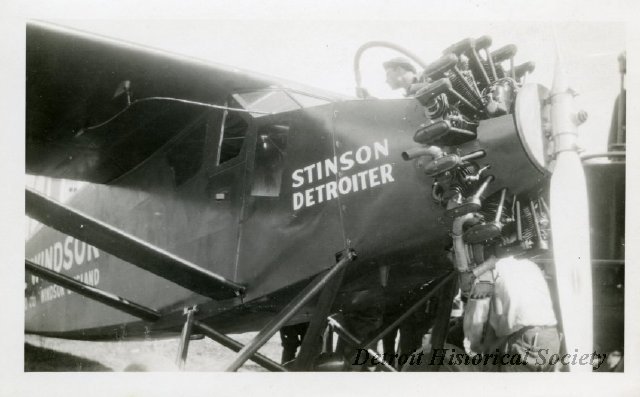Edward Anderson Stinson was an American pilot and aircraft manufacturer. Born on July 11, 1894 in Fort Payne, Alabama, Stinson developed an obsession with aviation at an early age. Following in the footsteps of his older sister Katherine, an early female aviator, Stinson earned his wings at the Wright School of Aviation in Dayton, Ohio under the tutelage of Roderick M. Wright. During World War I, he served as a flight instructor for the U.S. Army Air Corps at Kelly Field, where he helped to train thousands of pilots for overseas combat.
Following the war, Stinson founded the Stinson Aircraft Company in Dayton, Ohio in 1920 with his younger brother Jack. In 1921, Stinson’s reputation surpassed that of his sisters, Katherine and Marjorie, when he broke a world record for flight time by three hours. A year later he moved to Detroit to work for the Stout Engineering Company testing the Stout ST-1 bomber.
Detroit became the focus for all of Stinson’s future flying ventures. Collaborating with W.A. (Bill) Mara, a well-connected Detroit businessman, and a number of members of the Detroit Athletic Club, Stinson established the Stinson Aircraft Syndicate at a site southwest of Detroit in 1925. The prototype plane, dubbed the Stinson Detroiter by Mara, had a heated, enclosed cabin, an air-cooled engine, an electric starter, and other luxury features. Stinson is credited with adding wheel brakes to aircraft, another feature of the Detroiter aircraft. The later success of the SM-1 Detroiter plane enabled Stinson to transform the Syndicate into the Stinson Aircraft Corporation in 1926 in Northville, Michigan. A series of successful aircraft designs built by the Stinson Aircraft Corporation followed.
Stinson lived with his wife Estelle Judy and her son Raymond Judy, in a 6,000 square foot house known as Kingsbury Castle, built in 1927 in Dearborn, Michigan. Called “the dean of American fliers,” he set a second endurance record in 1928, staying in the air 53 hours and 37 minutes.
Unfortunately, Stinson was unable to enjoy the success created by promoting and developing his love of flying. In Chicago doing demonstration flights, his R-2 plane lost power on the last flight of the day, over Lake Michigan. Forced to make an emergency landing in the darkening sky, the right wing struck a flagpole at the Jackson Park Golf Course, and Stinson died from injuries he sustained during the crash landing. At the time of his death, on January 26, 1932, six months shy of his 37th birthday, Stinson had acquired more than 16,000 hours of flight time. After his death, the Stinson Aircraft Corporation continued to achieve success, and was eventually absorbed by larger corporate entities by the end of World War II.

